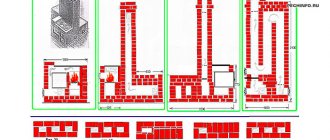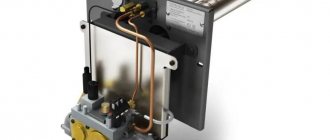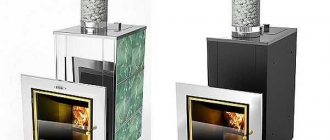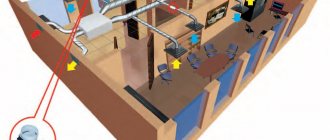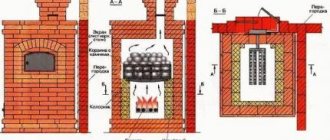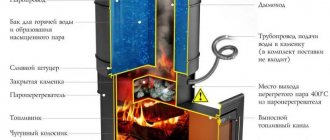Combustion process in a boiler
The chemical reaction inside the boiler is a combustion reaction between oxygen (O2) in the air and hydrocarbons (CHyOx) in the fuel, which release energy as heat. During the combustion process, water vapor (H2O) and carbon dioxide (CO2) are formed, the latter being especially dangerous in terms of air pollution and global warming.
Other combustion products of injector gas may also appear depending on the type of fuel and combustion conditions: oxides of nitrogen (NOx) or sulfur (SOx), which are responsible for acid rain. Carbon monoxide (CO), a dangerous toxic substance, can cause death if inhaled.
Correct adjustment of the device reduces the amount of harmful combustion products. CO2 emissions are reduced when the gas is completely burned. In order to reduce NOx emissions, it is recommended to use the correct combustion technology, which is ensured by the design of the burner device.
Characteristic
An acetylene welding torch is a special device into which a special gas (acetylene) is supplied for combustion. It is used more often than other devices for gas welding. The reasons for its popularity are quite obvious:
suitability for work even with a limited set of equipment;
high efficiency of application (justified even at nuclear and other critical facilities).
The combustion temperature of acetylene is higher than that of any other welding gas. It reaches 3200 degrees. The reason is that the acetylene combustion reaction is endothermic, while other gases absorb heat during the decomposition process. Complete combustion of 1 cu. m of this gas will require the use of 2.5 cubic meters. m. air. These are the calculations carried out by chemists based on the formulas of the reacting substances.
However, in practice, acetylene burns only incompletely in a flame, so during real welding the air consumption does not exceed 1-1.2 cubic meters. m. Because of this, the total useful heat productivity, instead of the theoretically calculated 13500 kcal per 1 m3, is only 5120 kcal per 1 m3. In practice, an oxygen-acetylene mixture is most often used, in which 55% is acetylene, and the remaining 45% of the mass is oxygen.
It is also useful to understand how an acetylene torch differs from a propane torch in practice. The first type is mainly used for working with relatively thin (no more than 6 mm) metal. The tips of the burner devices contain, in addition to the injector, also a mouthpiece and a tube. The proportions of the holes in the mouthpieces and injectors are calculated strictly individually for each gas used. Therefore, to replace the gas, you have to use a different tip, preferably from the same manufacturer.
Space heating devices
They mix fuel and oxygen and, with the help of an ignition device, ensure complete combustion, which occurs in the combustion chamber, and the heat is transferred to water through a heat exchanger. Control devices regulate ignition, combustion speed, fuel and air supply, exhaust draft, water temperature, steam and water pressure in the boiler.
The hot water produced by the boiler moves through natural circulation through the in-house heating system of the entire building. The heating circuit may include hot water heat exchangers, air conditioning and ventilation units.
Advantages and disadvantages
Using burner equipment already has the advantage that you no longer have to spend a lot of time igniting the furnace itself. The combustion process will be initiated as quickly as possible and will not require any special effort. You just need to unscrew the valve and put the system into operation. But it is also worth noting that gas fuel is significantly cheaper than heating with wood, coal, electricity or diesel.
Even taking into account the gradual convergence of prices, the opportunity to save space on fuel storage is very attractive.
It is also worth noting that the devices are quite safe in terms of fire. The designers did not stand still, but continuously solved the problems of fire protection with the means available to them. In addition, natural gas burns at a lower temperature than coal or other fuels. Therefore, the chimney will become less hot. However, in just 60-90 minutes the room will be completely heated.
How to choose?
What you need to pay attention to when choosing a burner device for a boiler:
- productive power - noise level during operation (applies to supercharged models) - type of heating equipment for which the burner is purchased - type of fuel - pros and cons of this device - provide for possible malfunctions in the operation of the local gas supply line.
Taking these factors into account, you can choose the most suitable burner device for your boiler so that it operates as efficiently as possible without the burden of frequent preventative maintenance.
Gas burners for heating
An integral part of boilers are gas burners for heating boilers. A burner is a device for combining oxygen with fuel (gas), after which this mixture is supplied to the outlet for further combustion to form a fire. They are easy to use and have a simple design. It takes very little time to ignite, it is not subject to spontaneous explosions and operates very quietly. They are used on various equipment - water heaters, heat generators, heating boilers, heat guns (mobile air heaters) and much more.
Gas burners can be operated on different fuels: natural and liquefied gas, which is supplied in special gas cylinders. Their use is safe and economical, especially for the private sector.
Burners can have different modes:
Single stage gas burners
Such gas burners for boilers operate only in two main modes: on - off. They are designed for heating boilers with a small power range and can only operate in one power range. The equipment's automation activates the burner when the temperature in the heating system drops and turns it off after heating.
This type of device is recommended for use with oxygen, which is supplied forcibly (inflatable method) and can be ventilated, replaceable or mounted. The resulting noise from their operation can be muffled by soundproofing casings or noise suppressors. When using single-stage burners, it is possible to use various gases:
To heat a residential building, single-stage burners of varying power are used. Equipment of such a boiler room does not require large financial investments. They can also differ from each other by different modifications:
Two-stage gas burners
They can be operated in a more complex mode - at low and preset power - and have an atmospheric burner, which operates much quieter than a single-stage inflatable one.
Low power allows you to start gas burners for heating and operate in a reduced mode. This is suitable for the autumn-spring period, when it is still warm outside and intensive heating of the room is not required. Based on this, the cost of a two-stage burner is slightly higher than a single-stage one, but it is more convenient to use and provides more operational possibilities.
Modulating or smoothly two-stage
This option is suitable for those who want to arrange a heating system that is completely independent and automated, with regulation that will depend on climatic conditions, and also economical, with low fuel consumption. Such a system will allow you to program the power and regulate the operating process of the device, which provides advantages in the use of modular devices.
Gas burners for heating boilers are an integral element when installing a boiler room in a private home and its heating system, so their choice must be approached correctly and thoughtfully. After all, the functionality of heating equipment and the entire home heating system depends on this. The equipment must be installed in accordance with all safety regulations in a specially designated room by qualified specialists.
Ignition type
All burners can be divided according to the type of ignition:
- Electronic type. They do not have a constantly working igniter. Requires electricity to operate. Electric ignition is one of the most convenient inventions for modern heating units. Thanks to him, the operation of the stoves has become as comfortable as possible. Electric ignition makes it possible to light the burner flame safely, without using available wicks or lighters.
- Burners with piezo ignition. No electricity needed.
Sometimes special working conditions are required, for example, burners are placed in a sauna stove, which must distribute the flame well. These are dividers or ordinary distribution tubes. This is how kitchen gas ovens work.
The fuel consumption passing through the burner can vary widely and depend on its design.
Gas burners for your furnace should be safe and energy efficient. This can be achieved if all technical requirements are met. Self-indulgence in this matter can only do harm. Therefore, the installation of gas burners must be carried out by specialists.
source
Safety rules when using burners
Failure to comply with precautions when installing and using gas burners for heating premises can lead to emergency situations and accidents: fire in the house, carbon monoxide poisoning.
When operating gas equipment, you should adhere to the following rules:
- Observe the service life. The burner's service life, depending on the model, can range from 8 to 15 years. Then it must be replaced.
- Use models with a function that automatically turns off the device in the absence of draft or flame.
- A stove equipped with gas burner units must meet safety requirements.
The design, installation or repair of a gas burner must be carried out by certified gas service workers, with whom an agreement has been concluded for the supply of fuel and maintenance of the units.
If possible, it is still necessary to use gas boilers or special furnaces that are designed to work with natural or liquefied gas
To obtain permission to install and connect to the main gas network, a number of conditions must be met:
- compliance with the rules for connecting a gas burner;
- appropriate design of the smoke channel, its high-quality insulation;
- installing a spark arrester at the top of the chimney.
This is the minimum requirement for installing forced-air gas burners.
For atmospheric there are additional requirements:
- presence of adjustable traction;
- ensuring good ventilation;
- the volume of the room in which the gas burner is installed is from 12 m3.
If equipment is converted to use liquefied gas, it is necessary to ensure safe storage of the gas cylinder. This can be a separate room or a metal cabinet. If you plan to store gas reserves in a gas tank, then the tank is installed underground at a distance of no closer than 5 m from the building.
Photos in the text to illustrate what was said
Atmospheric gas burner for furnace
Atmospheric nozzle with flame dividers
Gas burner with nozzle and power adjustment
Blast gas burners with nozzle
Turbocharged air injectors
Installation of a gas burner in a heating furnace
We remind you that it is prohibited to install gas equipment yourself. However, it won’t hurt to familiarize yourself with the nuances of installing a gas burner in a stove.
So, installation of a gas burner is permissible in furnaces in which the length, shape, nature and temperature of the flame can be adapted to the nature of the material of the combustion chamber. The flame should not touch the walls, but should be freely located in the combustion space. If it is a brick wall, then the firebox should be made of refractory bricks.
Before installation, check the walls of the stove for cracks, voids, and unsealed seams through which combustion products can enter the room. The room into which the firebox door opens must have an opening window, a ventilation duct and a gap in the door for air to enter from below.
Gas burners of any type are characterized by the creation of high temperatures - more than 1000 °C in the combustion chamber. When installing a gas burner in the oven, you must ensure that the flame does not touch the walls.
The installation process itself is not complicated and is carried out in the following sequence:
- Remove the firebox door.
- A burner is placed in the combustion chamber.
- The shield is secured in the door frame.
- Connect the automation according to the manufacturer's instructions.
At the end of installation, connect the burner to a hose, the other end of which is connected to a gas source.
Installing a burner using the example of an AGG gas burner device: the stage of installing a gas burner block in a furnace with dismantling the ash pan
The system is launched by a master from the gas service, he checks the operation of the nozzles, the automatic control and safety systems, configures and tests the response of the sensors.
Installation of a gas burner in an industrial furnace using the example of an AGG gas burner device. Connecting automation, placing the remote control and thermal cylinder
Another step is to check the tightness of all connections and the presence of traction. After successful startup of the system, the gas installer must issue a completed control certificate for the installation of the burner.
When starting the heating, you should first select the minimum thermal power, heating the stove continuously and little by little or, if there is no power adjustment, cyclically, turning the burner on and off. This is especially important for a brick kiln - strong continuous heating of a cooled brick can lead to cracking.
General rules for installing a chimney for a stove
Another condition for the normal operation of a gas stove is the installation of a chimney. For gas-fired stoves, smoke channels must be vertical, without ledges. The design of the chimney of a wood-burning stove is often not suitable for the removal of gas combustion products.
The slope of the chimney is allowed, but not more than 30°, and provided that the cross-section of pipes on inclined sections is not less than the cross-section of pipes installed vertically
Teplodar boilers are a universal heat source for your home
One of the most effective and affordable ways to organize heating is to install a universal boiler. As an example, we can cite the “Kupper PRO” line of our production.
Solid fuel boilers with a power of 22-42 kW are equipped with heating elements, and gas and pellet burners can be installed on them. When burning solid fuel, they can be switched to a long-term combustion mode. The operation of the gas burner is fully automated.
You can get advice on the selection and operation of boilers with gas burners from our managers via online chat or by phone.
Operating principle of an atmospheric burner
The gas, entering the nozzle nozzle, increases its speed and creates a vacuum at the base of the torch, which sucks in part of the combustion air, the so-called primary air, forming a gas-air mixture.
The main air-gas mixture enters a series of holes (circular, inclined, straight) located on one or several tiers of the device. The mixture is ignited using a pilot light. The additional air required for combustion, called secondary air, is drawn into the flame by induction due to natural convection.
A homemade gas burner for heating with domestic gas has a percentage of primary air from 40 to 50%. All parts of the device (nozzles, mixing tubes) structurally ensure stable combustion of fuel without loss. However, this type of burner does not have the ability to manually control the combustion process. The combustion process is strictly ensured by the burner design and fuel parameters.
While the big advantage of boilers equipped with an atmospheric burner (power up to 1 MW) is the simplicity of the system, they have major disadvantages:
- no emergency shutdown of the combustion process during operation of a brick kiln in the event of a sudden stop in the fuel supply;
- excess air;
- poor combustion efficiency;
- significant production of NOx.
Equipment setup
Floor-standing gas boilers with an atmospheric burner can be configured independently. Pressurized systems are regulated by an automatic control unit and do not require additional configuration.
Scheme of actions for setting up single-stage equipment:
- Install the device on the boiler.
- Connect to the gas pipe.
- Check for absolute tightness.
- Remove the burner housing.
- Using a pressure gauge, measure the gas pressure at the inlet.
- Connect to electricity. Make sure that the jumpers and phases are connected correctly.
- Place a gas analyzer in the chimney pipe.
- Start the device.
- Using a pressure gauge, take pressure readings at the outlet of the burner block. Pressure readings must correspond to the parameters indicated in the data sheet.
- Adjust the air flow using the air damper.
- The gas analyzer readings must also comply with all gas equipment installation standards.
Setting up gas equipment should be carried out by specialists. The simplest open-type boilers can be configured independently if you have certain skills and knowledge of the design of the burner unit. The efficiency of the boiler, its level of efficiency, and fuel consumption depend on the quality of the burner. It is possible to superficially determine that the equipment is malfunctioning by the changed burner flame.
A heating system where the main element is a gas stove is a common type of heating for private households and cottages. There are many things in favor of natural gas as a heat source: high efficiency, environmental friendliness, and the ability to make the heating process fully automated. The fuel itself is also the most inexpensive at present, unless, of course, you take into account wind energy and solar radiation. But these methods have not yet found wide demand due to the unaffordable price of the equipment.
The quality of gas heating depends on how efficiently the gas burner for the stove works.
Pulse burner design
It has a higher efficiency compared to natural ones, is more efficient and complex in design. The fuel burner consists mainly of seven elements:
- Fuel pump, it supplies the boiler with fuel from the tank (liquid fuel) and is equipped with a pressure regulator that returns the excess fuel required for combustion.
- The fan provides the combustion process with the air necessary to burn the fuel.
- A solenoid valve is a valve that operates automatically. It is used to supply a jet of fuel in sufficient quantity for combustion.
- The nozzles are the central part of the burner. The nozzle allows the fuel to be atomized very finely to promote thorough mixing with air to form a fuel-air mixture for combustion.
- A fuel heater, it allows the liquid fuel contained in the tank to be made less viscous to aid combustion. This initial viscosity is related to the storage temperature in the tank as well as the specific characteristics of the fuel.
- Electrodes, they allow you to ignite the gas-air mixture to create the desired flame.
- The combustion head, which consists of two elements. The tip that directs the flame and the reflector that holds the flame in the stove.
The burner operating mode can be divided sequentially into stages:
- Pre-ignition. Turning on the fan, which allows the engine to run.
- Ignition. Opening of the solenoid valve, which directs fuel to the nozzle.
- Ignition. A spark is created to maintain a stable combustion flame.
- Operating mode. Turn off the igniter after the flame has stabilized.
- Stop. Closing the solenoid valve, turning off the burner and after 15 - 20 minutes of ventilation of the firebox in order to free the combustion space from explosive mixtures, turning off the fan.
Trouble-shooting
Having a boiler at home brings many advantages, but it also has a number of disadvantages, and the user does not always know what to do correctly. Boiler faults are common to many types. It is important to promptly determine the cause of these faults before calling emergency services. List of the most common and most likely faults.
First of all, if the boiler does not start, you need to check the circuit components:
- network voltage;
- faulty boiler fan switch or motor;
- damaged boiler cables;
- false triggering contacts of automation or commissioning equipment;
- availability of water, whether the gas boiler is powered to the minimum required level specified by the equipment manufacturer.
If the boiler failure is not caused by any of these problems, the following procedure:
- Pay attention to the noises made by the boiler, because they are often the first witnesses of destruction. They can also be due to hot water trapped inside the firebox or due to the presence of air in the heating system due to clogged air ducts.
- Pipe rupture. It usually occurs due to problems with a jammed boiler feed valve, various scale-forming deposits in the boiler, or a malfunction of the condensate drainage systems.
- Failures due to exceeding the pressure and temperature readings, their corresponding sensors can trigger, for example, due to a broken thermometer or, conversely, which is especially dangerous as a result of real overheating of the boiler.
- The heating circuits are not working, possibly due to poor quality of feed water and scale formation in the boiler pipes.
- A problem occurs with the burner (flame breaks, gas accumulation causes detonation and explosion).
For some of these problems, mainly pressure or temperature, the boiler monitor displays an error message, then the system shuts down and automatically restarts. If the problem persists after restarting, it is best to call a professional to troubleshoot the problem. It should be noted, however, that most of these failures can be avoided.
The best prevention is to have your boiler inspected, maintained and cleaned annually, usually by a professional. This will prevent the pipes from clogging and bursting. Prevention is better than restoration, and a simple annual inspection will protect the equipment and the health of users from possible emergency situations.
Required Permissions and Installation Requirements
To install a burner in a sauna stove, permission from the gas supply authorities is required. In the case of atmospheric devices, operating conditions must meet the following requirements:
- the presence of a high-quality room ventilation system,
- adjustable traction,
- the volume of the premises being used is at least 12 m³,
- ensuring fire safety measures: reliable insulation of the chimney when laying the chimney through the floor slabs and roofing system, equipping the top with a spark arrester.
When purchasing a device, a set of documents is included in the form of certificates of conformity and permission from Rostechnadzor. If the installation rules are followed and the above documentation is available, there is a chance to obtain permission for operation from the gas supply organization.
When installing supercharged models, it is sufficient to comply with fire safety rules and the availability of accompanying documentation, since due to the features of the functionality, there are no requirements for the place of operation.
It is worth considering that all this is valid when using main gas. In the case of autonomous gasification, for storing liquefied gas cylinders, according to the regulations, a separate metal cabinet is used or a gas tank is equipped. The underground tank provides for volumes of 3 m³ and a location at least 5 m from the building. A pipeline of steel pipes is laid from the storage facility to the heat generator, ensuring reliable tightness of the channel.
DIY options
Often, a homemade gas heating unit is made from an old empty cylinder, which is first filled with water to remove any remaining fuel. To assemble a metal heat generator with your own hands, use ready-made drawings.
Materials and tools:
- empty gas cylinder. You can buy a new cylinder or find a used one at a scrap metal collection point,
- used wheels from trucks and cars, they are selected depending on the expected power of gas-fuel heating equipment,
- metal pipes. For gas and air supply, a model with a cross section of 2 cm is used; for the construction of a chimney, a pipe with a diameter of 4 cm is suitable,
- atmospheric burner,
- Bulgarian,
- drill with appropriate attachments,
- welding machine.
Sequence of work:
- Using a grinder, cut a hole in the upper part of the cylinder to fit the dimensions of the wheel rim.
- The disk is inserted into the hole and welded using a welding machine.
- The air supply structure is made from a pipe d2 cm by drilling 9-11 holes with a diameter of 5 mm on the surface.
- A hole d50 mm is drilled in the lower part of the cylinder, a pipe is inserted so that on one side it protrudes 15-20 cm. The seams are sealed by welding.
- The gas pipe is welded in a similar way, the free end is equipped with an adapter for connection.
- A chimney is installed in the upper part of the structure.
At the end, the firebox door is made from a steel plate, a hole is cut out from the side of the homemade structure for it and installed on the hinges.
Hand-drawn diagram of a homemade gas burner for a sauna stove
Technology for making homemade metal gas burners
To make a gas burner for an atmospheric sauna stove with your own hands, you can use available materials in the form of scraps of metal pipes and suitable elements from old equipment.
Tools, devices and materials:
- Bulgarian,
- welding machine,
- steel tube with a wall thickness of 2 mm and a length of 100 mm,
- valve - to regulate the fuel supply,
- steel cap - a blowtorch jet is suitable,
- piezoelectric element,
- rubber for handle.
When preparing the material base for a homemade gas injector, the peculiarities of connecting the elements are taken into account. For example, the standard VK-74 valve provides a cap with a conical thread.
Stages of work:
- to make a fuel dispenser, a steel cap is screwed onto the valve,
- using a grinder, the base of the device is made from a steel pipe - a nozzle,
- the nozzle is welded to the cap,
- The design is equipped with a piezoelectric element.
When planning to make a gas burner with your own hands, it is worth considering that the regulations provide for mandatory testing of the quality of the product at the local office of Rostekhnadzor and obtaining a certificate of fitness for use.
Classification of species
Manufacturers offer two types of gas burners for sauna stoves:
- atmospheric,
- supercharged.
Models vary in design characteristics and have different advantages and disadvantages.
Atmospheric burner for sauna stove
Atmospheric burners
Atmospheric devices are sold in an affordable segment, are non-volatile, and provide a minimum of automation. The design consists of one or more hollow tubular elements for supplying gas under pressure. To operate atmospheric burners for sauna stoves, good air circulation in the room is required.
Pros:
- autonomy,
- simplicity of design,
- compactness,
- quiet operation,
- availability.
Minuses:
- relatively low power,
- low level of efficiency.
The high traction requirements must also not be overlooked.
Pressurized gas burners for sauna stoves
Blowing devices structurally look like a block with sensors equipped with a controller. The package includes a fan for forced air supply to the firebox.
Pros:
- multi-stage security systems and high-quality automation are provided,
- 2 times more economical than the atmospheric model,
- the ability to adjust to any power in a wide range,
- possibility of conversion to liquefied gas and vice versa.
Minuses:
- energy dependence,
- high price.
To level out dependence on the electrical network, it is recommended to use a diesel generator or other alternative source.
Pressurized burner for sauna stove
